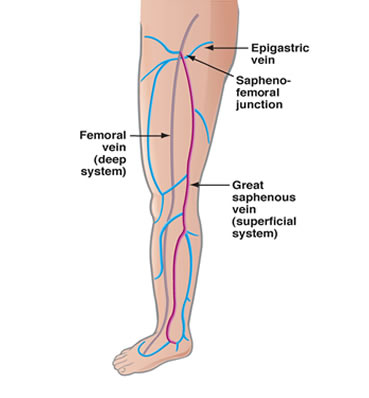Venous Reflux Disease



Your body contains approximately 60,000 miles of veins, which are blood vessels that pump blood back to the heart, as opposed to arteries which carry blood away from the heart. The veins in the legs have a tough job; they must defy gravity to get the blood back to the heart. This is especially true for someone who spends long periods of time on their feet or even sitting. Veins contain valves which help to prevent the blood from flowing backwards. When these valves become damaged, they no longer close properly causing blood to pool in the legs and the vein to become enlarged which damages the valves even more. These enlarged veins, known as varicose veins, look blue in color and can bulge under the skin. This condition of blood flowing back down the leg is also known as venous reflux disease.
What Causes Vein Disease and Varicose Veins?
There can be many factors that contribute to vein disease, including:
- Heredity- Weak vein valves often run in families. Almost 50% of varicose vein sufferers have a family member who also has them.
- Age- The valves in the veins become weaker over time as you age and they may not function as well.
- Long Periods of Standing- Standing for prolonged periods puts pressure on the veins, as well as causing them to work harder to fight gravity and pump blood back up to your heart.
- Long Periods of Sitting- Lack of movement can result in poor blood flow. Crossing your legs when you sit can make this problem worsen.
- Weight- Carrying extra weight puts extra pressure on your veins, such as pregnancy.
- Hormones- Hormonal changes such as puberty, pregnancy, menopause, or taking birth control have been linked to the forming of spider and varicose veins.
Why Should Varicose Veins Be Treated?
Varicose veins are much more than just a cosmetic inconvenience. These swollen veins can be painful, especially when standing as the vein is withstanding a lot of pressure. Varicose veins can also lead to swollen and throbbing limbs, heaviness of limbs, cramping, thickening of the skin, skin rashes and ulcers, and fatigue. This may reduce one’s activity level, which has further negative impact on cardiovascular health.
The visible varicose veins are the larger veins close to the surface of the skin. However, small veins can be affected as well. These are called spider veins. Most of the veins are well below the skin’s surface, and therefore not seen with the naked eye. This is why a vein mapping ultrasound is used to identify and determine the extent to which the veins in your legs are affected by vein disease.
Advanced Imaging Technology Used in the Diagnosis and Treatment of Varicose and Spider Veins
At Heart Vein & Vascular we use an advanced high resolution diagnostic ultrasound to diagnose the severity of your condition. We offer many types of treatments for varicose and spider veins, including conservative vein treatments and the minimally invasive VNUS Closure® procedure. HVV will provide you with a thorough evaluation to determine the best course of treatment for you depending on your lifestyle and severity of your varicose veins. We believe patients should be educated on their condition and treatment, and do not simply treat for cosmetic purposes.
Call or Contact the Heart Vein & Vascular today to learn more about which treatment option is best for you.
